Assessing Grain-Size and Sedimentological Variations in Human-Modified Beaches: Insights from the Northern Adriatic Coast (Italy)
Abstract
1. Introduction
2. Selected Sites
3. Materials and Methods
4. Results
4.1. Morpho-Sedimentological Features of the Investigated Beaches
- Coastal dunes: In this area (as in many other heavily anthropized areas), coastal dunes were almost completely dismantled after the Second World War to make space for tourist infrastructure [20]. Today, remnants of these dunes are limited to a few areas, and they are substantially stabilized by vegetation (Figure 3a). Due to the presence of artificial structures (e.g., bathing facilities), landward aeolian sediment transport is obstructed, preventing the natural replenishment of dunes. These obstacles promote the formation of new aeolian accumulations during the winter months, which are subsequently removed at the beginning of the spring season.
- Artificial dunes/barriers: During autumn, artificial dunes or sand barriers are constructed parallel to the shoreline to protect inland areas from storm-induced marine inundation (Figure 3b). These structures are created by bulldozers pushing and accumulating beach sand in tight areas. Barriers have a trapezoid shape, and are approximately 2 m high and 6 m wide. The top of the barriers is flat and the landward side is generally close to the repose angle (i.e., 17–27°) while the seaward side is generally less inclined (i.e., 8–20°). Similarly to those that happen in natural dunes, the sides are characterized by en-masse processes triggered by gravitational instability, resulting in the accumulation of grain-flow deposits at the toe of the barrier. During major storms, waves can partially erode these structures that are dismantled in the spring, i.e., before the tourist season.
- Backshore: This area is the most devoted to tourism activities and this is, probably, the zone more modified by human activity: it is mechanically leveled at the beginning of the tourist season, and again at the end of summer for the construction of artificial dunes (Figure 4a). Moreover, during the tourist season, every morning this zone is sieved with operating machines to remove rubbish and shell fragments. The sieved materials are firstly cleaned from rubbish, and then the inorganic coarse-grained fractions (shells, granules, and uncommon pebbles) are thrown close to the shoreline, in the berm zone, or directly in the foreshore (Figure 4b). While this practice is sustainable in terms of sediment budget since it does not result in sediment loss from the beach system, it can lead to granulometric overestimations if samples are taken in these anthropogenically altered zones or closely spaced areas.
- Storm berm: The storm berm can be observed only occasionally (once in our fieldwork) and only during the winter season because, during spring and summer, this morphological feature is destroyed by human actions. Also, during the winter, storm berms can be recognized only on shorelines not protected by parallel shore barriers.
- Fair-weather berm and runnel: In partially protected areas, fair-weather berms (hereafter “berm”) commonly occur even if these structures have a low relief (max 20–30 cm). A runnel typically occurs just landward of the berm crest (Figure 4c). In contrast, in areas that are fully protected by hard shore-parallel structures, berms are usually absent or, when present in winter, display minimal relief (max. 10 cm; Figure 4d). In such cases, the backshore connects directly to the foreshore via a flat, gently sloping surface. During spring and summer, berms are regularly cleaned using sieving machines that remove rubbish sensu lato, including Posidonia oceanica leaves and remains of algae. These materials are removed from the beach and from a sediment budget point of view, this practice is problematic because sand grains tend to adhere to Posidonia oceanica leaves and, consequently, these sediments are removed from the system. Considering the substantial quantities of Posidonia oceanica removed during the summer and these beaches’ erosive dynamics, this sediment depletion may aggravate existing sediment budget issues.
- Foreshore: The foreshore (Figure 5a) is generally defined as the area between high and low tide [21,22,23,24]. This definition is the most applicable in the investigated area, even if other foreshore classifications have been proposed over time (see [25] for a comprehensive review). It is probably the easiest zone to detect and the less disturbed by human activities, primarily because the constant wave action rapidly erases signs of human activity, allowing natural processes to dominate. The foreshore slope ranges from 1° to 5°. Recognizing the high-tide boundary in the field is relatively easy thanks to concentrations of Posidonia oceanica leaves, algae, shells and macroplastic fragments that highlight it (Figure 5b). In fair-weather conditions, this zone tends to host the greatest concentration of macroplastics along the beach profile. The low-tide boundary is more difficult to identify when observations are conducted in a moment different from the low-tide minimum. In such cases, accurate identification requires tidal correction and the use of a measuring rod to determine the corresponding water depth.
- Step: Beach steps are morpho/sedimentological features typically found on steep, coarse-grained sand or gravelly beaches, but they can also occur on gently sloping, fine-grained sand beaches [23,24,25]. According to [26], the beach step is a submerged scarp located at the base of the foreshore. As with other features, its occurrence differs depending on the presence of protective structures. On fully protected beaches, steps are often absent or appear as subtle scarps, sometimes identifiable by alongshore alignments of coarse sediment or thin (≤1 cm) shell fragment layers. However, distinguishing these features from similar sedimentary alignments in the foreshore can be challenging. In partially protected sectors, steps are more pronounced, although their relief typically does not exceed 10 cm (Figure 6a,b).
- Shallow shoreface: The shoreface was surveyed only to a depth of approximately 0.5 m. Within this range, it consistently exhibited symmetrical ripples formed by wave action. These wave ripples are generally absent only in narrow zones landward of coastal protection structures where the seabed is flat.
4.2. Grain-Size Data
4.2.1. Median Grain Size (D50)
4.2.2. Mean Grain Size (Mz)
4.2.3. Sorting (σ)
4.2.4. Skewness (Sk)
5. Discussion
5.1. Identifying Suitable Areas for Beach Monitoring
5.2. Grain-Size Characterization: Which Areas Are Most Suitable for Geological Investigation?
6. Conclusions
- The berm is sensitive to seasonal changes, showing statistically significant differences in D50, Mz, and sorting between summer and winter conditions—variations likely influenced by both natural wave energy regimes and the intensity of human beach maintenance;
- The step sub-environment, on the other hand, reflects differences between protected and partially protected settings, particularly in D50, Mz, and skewness values.
Supplementary Materials
Author Contributions
Funding
Data Availability Statement
Acknowledgments
Conflicts of Interest
References
- Gao, S.; Collins, M.B. Analysis of Grain Size Trends, for Defining Sediment Transport Pathways in Marine Environments. J. Coast. Res. 1994, 10, 70–78. [Google Scholar]
- Guillén, J.; Palanques, A. Short- and Medium-Term Grain Size Changes in Deltaic Beaches (Ebro Delta, NW Mediterranean). Sediment. Geol. 1996, 101, 55–67. [Google Scholar] [CrossRef]
- Lapietra, I.; Lisco, S.; Capozzoli, L.; De Giosa, F.; Mastronuzzi, G.; Mele, D.; Milli, S.; Romano, G.; Sabatier, F.; Scardino, G.; et al. A Potential Beach Monitoring Based on Integrated Methods. J. Mar. Sci. Eng. 2022, 10, 1949. [Google Scholar] [CrossRef]
- Lapietra, I.; Lisco, S.N.; Milli, S.; Rossini, B.; Moretti, M. Sediment Provenance of a Carbonate Bioclastic Pocket Beach—Le Dune (Ionian Sea, South Italy). J. Palaeogeogr. 2022, 11, 238–255. [Google Scholar] [CrossRef]
- Lapietra, I.; Lisco, S.; Mastronuzzi, G.; Milli, S.; Pierri, C.; Sabatier, F.; Scardino, G.; Moretti, M. Morpho-Sedimentary Dynamics of Torre Guaceto Beach (Southern Adriatic Sea, Italy). J. Earth Syst. Sci 2022, 131, 64. [Google Scholar] [CrossRef]
- Dean, R.G.; Galvin, C.J. Beach Erosion: Causes, Processes, and Remedial Measures. CRC Crit. Rev. Environ. Control 1976, 6, 259–296. [Google Scholar] [CrossRef]
- Willis, C.M.; Griggs, G.B. Reductions in Fluvial Sediment Discharge by Coastal Dams in California and Implications for Beach Sustainability. J. Geol. 2003, 111, 167–182. [Google Scholar] [CrossRef]
- Graffin, M.; Regard, V.; Carretier, S.; Maffre, P.; Almar, R. On the Overlooked Impact of River Dams on Beach Erosion Worldwide. 2021. Available online: https://eartharxiv.org/repository/view/2594/ (accessed on 1 October 2025).
- ARPAE Emilia-Romagna. Stato Del Litorale Emiliano-Romagnolo: Erosione e Interventi Di Difesa. 2018. Available online: https://ambiente.regione.emilia-romagna.it/it/suolo-bacino/argomenti/difesa-della-costa/stato-del-litorale-emiliano-romagnolo-allanno-2007-e-piano-decennale-di-gestione (accessed on 1 October 2025).
- Sytnik, O.; Del Río, L.; Greggio, N.; Bonetti, J. Historical Shoreline Trend Analysis and Drivers of Coastal Change along the Ravenna Coast, NE Adriatic. Environ. Earth Sci. 2018, 77, 779. [Google Scholar] [CrossRef]
- Davies, J. A Morphogenic Approach to World Shorelines; a Morphogenic Approach to World Shorelines. Z. Geomorphol. 1964, 8, 127–142. [Google Scholar] [CrossRef]
- ARPAE Emilia-Romagna Caratterizzazione Dei Sedimenti Delle Spiagge Oggetto Di Ripascimento (Area Romagna) e Dell’area off-Shore: Relazione Finale. 2021. Available online: https://ambiente.regione.emilia-romagna.it/it/suolo-bacino/documentazione/gare-e-appalti-pubblici/progettone-4/doc-progetto-4/p4_l1e_allegato-tecnico_c-caratterizzazione-sedimenti.pdf (accessed on 1 October 2025).
- Poullet, P.; Muñoz-Perez, J.J.; Poortvliet, G.; Mera, J.; Contreras, A.; Lopez, P. Influence of Different Sieving Methods on Estimation of Sand Size Parameters. Water 2019, 11, 879. [Google Scholar] [CrossRef]
- Román-Sierra, J.; Muñoz-perez, J.J.; Navarro-Pons, M. Influence of Sieving Time on the Efficiency and Accuracy of Grain-size Analysis of Beach and Dune Sands. Sedimentology 2013, 60, 1484–1497. [Google Scholar] [CrossRef]
- Blott, S.J.; Pye, K. GRADISTAT: A Grain Size Distribution and Statistics Package for the Analysis of Unconsolidated Sediments. Earth Surf. Process. Landf. 2001, 26, 1237–1248. [Google Scholar] [CrossRef]
- Gerald, M. Friedman Comparison of Moment Measures for Sieving and Thin-Section Data in Sedimentary Petrological Studies. SEPM JSR 1962, 32, 15–25. [Google Scholar] [CrossRef]
- McManus, J. Grain Size Determination and Interpretation. Tech. Sedimentol. 1988, 51, 63–85. [Google Scholar]
- Wilcoxon, F. Individual Comparisons by Ranking Methods. Biom. Bull. 1945, 1, 80. [Google Scholar] [CrossRef]
- Mann, H.B.; Whitney, D.R. On a Test of Whether One of Two Random Variables Is Stochastically Larger than the Other. Ann. Math. Statist. 1947, 18, 50–60. [Google Scholar] [CrossRef]
- Nordstrom, K.F. Coastal Dunes. In Coastal Environments and Global Change; Masselink, G., Gehrels, R., Eds.; Wiley: Hoboken, NJ, USA, 2015; pp. 178–193. ISBN 978-0-470-65660-0. [Google Scholar]
- Johnson, D.W. Shore Processes and Shoreline Development; John Wiley & Sons, Incorporated: Hoboken, NJ, USA, 1919; ISBN 0-7222-2628-4. [Google Scholar]
- Gresswell, R.K. The Physical Geography of Beaches and Coastlines; Hulton Educational Publication: London, UK, 1957; ISBN 0-7175-0398-4. [Google Scholar]
- Bird, E.C.F. Coastal Geomorphology: An Introduction, 2nd ed.; John Wiley & Sons: Chichester, UK, 2008; ISBN 978-0-470-51729-1. [Google Scholar]
- Haslett, S. Coastal Systems; Routledge: London, UK, 2008; ISBN 978-0-203-89320-3. [Google Scholar]
- McGlashan, D.J.; Duck, R.W.; Reid, C.T. Defining the Foreshore: Coastal Geomorphology and British Laws. Estuar. Coast. Shelf Sci. 2005, 62, 183–192. [Google Scholar] [CrossRef]
- Bauer, B.O.; Allen, J.R. Beach Steps: An Evolutionary Perspective. Mar. Geol. 1995, 123, 143–166. [Google Scholar] [CrossRef]
- Robert, T.G.; Orrin, H. Pilke Atlantic Beach and Dune Sediments of the Southern United States. SEPM JSR 1965, 35, 900–910. [Google Scholar] [CrossRef]
- Hjulström, F. Studies of the Morphological Activity of Rivers as Illustrated by the River Fyris. Ph.D. Thesis, The Geological Institution of the University of Upsala, Uppsala, Sweden, 1935. [Google Scholar]
- Hine, A.C. Mechanisms of Berm Development and Resulting Beach Growth along a Barrier Spit Complex. Sedimentology 1979, 26, 333–351. [Google Scholar] [CrossRef]
- David, B. Significance Of Skewness In Recent Sediments, Western Pamlico Sound, North Carolina. SEPM JSR 1964, 34, 864–874. [Google Scholar] [CrossRef]
- Carranza-Edwards, A.; Kasper-Zubillaga, J.J.; Rosales-Hoz, L.; Morales-de la Garza, E.A.; Lozano-Santa Cruz, R. Beach Sand Composition and Provenance in a Sector of the Southwestern Mexican Pacific. Rev. Mex. Cienc. Geol. 2009, 26, 433–447. [Google Scholar]
- Houghton, J.E.; Behnsen, J.; Duller, R.A.; Nichols, T.E.; Worden, R.H. Particle Size Analysis: A Comparison of Laboratory-Based Techniques and Their Application to Geoscience. Sediment. Geol. 2024, 464, 106607. [Google Scholar] [CrossRef]
- Pettijohn, F.J.; Potter, P.E.; Siever, R. Sand and Sandstone; Springer Science & Business Media: Berlin/Heidelberg, Germany, 2012; ISBN 1-4612-1066-6. [Google Scholar]
- Folk, R.L.; Ward, W.C. Brazos River Bar [Texas]; a Study in the Significance of Grain Size Parameters. J. Sediment. Res. 1957, 27, 3–26. [Google Scholar] [CrossRef]
- Borzì, L.; Marino, M.; Stagnitti, M.; Stefano, A.D.; Sciandrello, S.; Cavallaro, L.; Foti, E.; Musumeci, R.E. Impact of Coastal Land Use on Long-Term Shoreline Change. Ocean Coast. Manag. 2025, 262, 107583. [Google Scholar] [CrossRef]
- Buttò, S.; Faraci, C.L.; Corradino, M.; Iuppa, C.; Colica, E.; Pepe, F. Evaluating Longshore Sediment Transport: A Comparison between Empirical Formulas and XBeach 2DH Numerical Model. Mar. Geol. 2025, 480, 107471. [Google Scholar] [CrossRef]
- Reguero, B.G.; Losada, I.J.; Méndez, F.J. A Global Wave Power Resource and Its Seasonal, Interannual and Long-Term Variability. Appl. Energy 2015, 148, 366–380. [Google Scholar] [CrossRef]
- Katoh, K.; Yanagishima, S. Berm Formation and Berm Erosion. In Proceedings of the Coastal Engineering, Venice, Italy, 4–9 October 1992; American Society of Civil Engineers: Venice, Italy, 1993; pp. 2136–2149. [Google Scholar]
- OKAZAIU, S.; SUNAMURA, T. Quantitative Predictions for the Position and Height of Berms. Geogr. Rev. Jpn. Ser. B 1994, 67, 101–116. [Google Scholar] [CrossRef]
- Jensen, S.G.; Aagaard, T.; Baldock, T.E.; Kroon, A.; Hughes, M. Berm Formation and Dynamics on a Gently Sloping Beach; the Effect of Water Level and Swash Overtopping. Earth Surf. Process. Landf. 2009, 34, 1533–1546. [Google Scholar] [CrossRef]
- Bendixen, M.; Clemmensen, L.B.; Kroon, A. Sandy Berm and Beach-Ridge Formation in Relation to Extreme Sea-Levels: A Danish Example in a Micro-Tidal Environment. Mar. Geol. 2013, 344, 53–64. [Google Scholar] [CrossRef]
- Suzuki, T.; Takeuchi, M.; Tomoda, N.; Yamaguchi, S.; Kuriyama, Y. Spatial Distribution of Cross-Shore Sediment Transport Rate for Berm Formation and Erosion. In Proceedings of the Coastal Sediments ’07, New Orleans, LO, USA, 13–17 May 2007; American Society of Civil Engineers: New Orleans, LO, USA, 2007; pp. 2037–2048. [Google Scholar]
- Orton, G.J.; Reading, H.G. Variability of Deltaic Processes in Terms of Sediment Supply, with Particular Emphasis on Grain Size. Sedimentology 1993, 40, 475–512. [Google Scholar] [CrossRef]
- Nordstrom, K.F. The Use of Grain Size Statistics to Distinguish between High-and Moderate-Energy Beach Environments. J. Sediment. Res. 1977, 47, 1287–1294. [Google Scholar]
- Stauble, D.K.; Hansen, M.; Blake, W. An Assessment of Beach Nourishment Sediment Characteristics. In Coastal Engineering; American Society of Civil Engineers: Houston, TX, USA, 1985; pp. 1471–1487. [Google Scholar]
- Davison, A.T.; Nicholls, R.J.; Leatherman, S.P. Beach Nourishment as a Coastal Management Tool: An Annotated Bibliography on Developments Associated with the Artificial Nourishment of Beaches. J. Coast. Res. 1992, 8, 984–1022. [Google Scholar]
- Jackson, N.L.; Nordstrom, K.F. Aeolian Sediment Transport and Landforms in Managed Coastal Systems: A Review. Aeolian Res. 2011, 3, 181–196. [Google Scholar] [CrossRef]

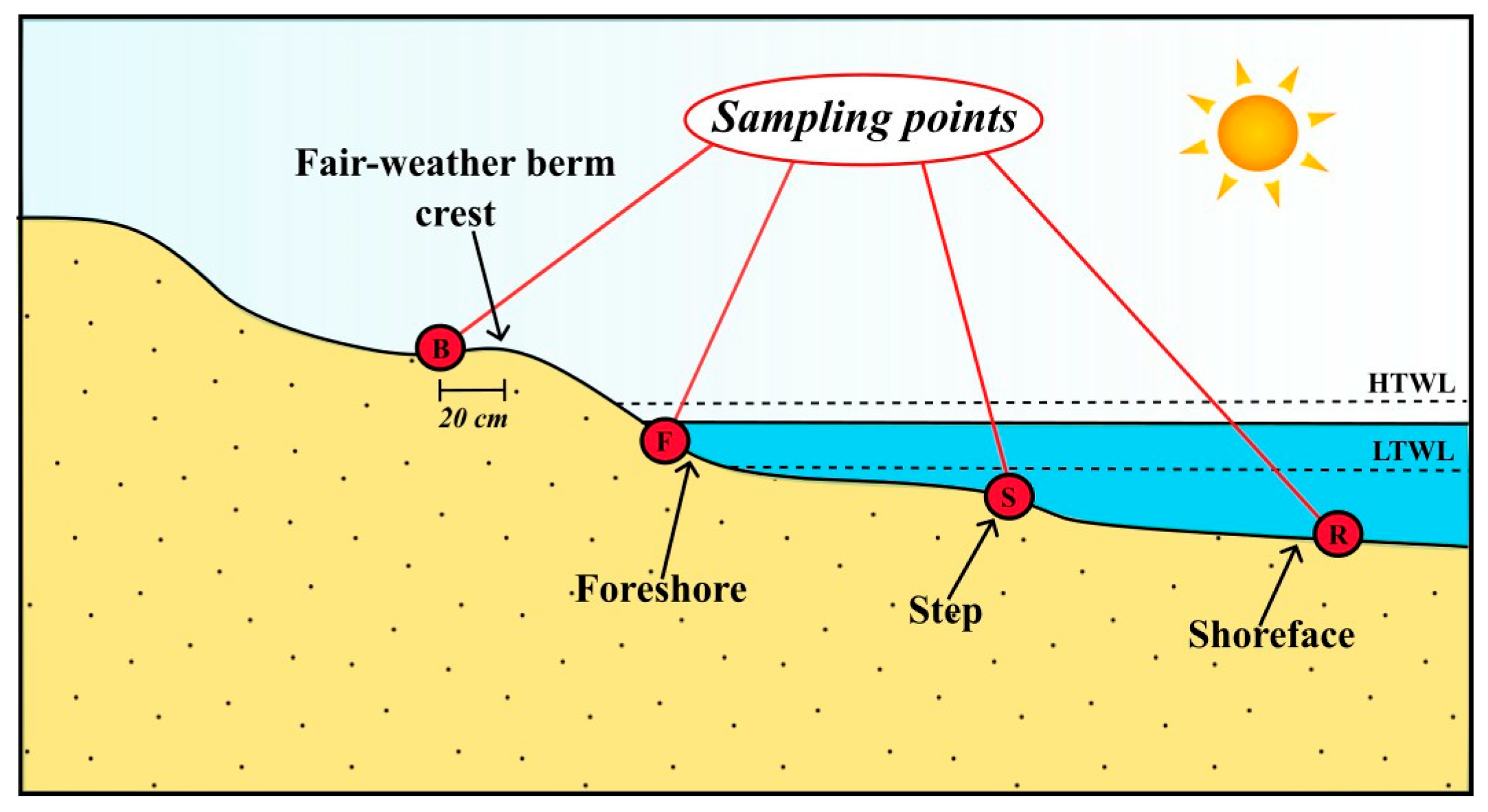
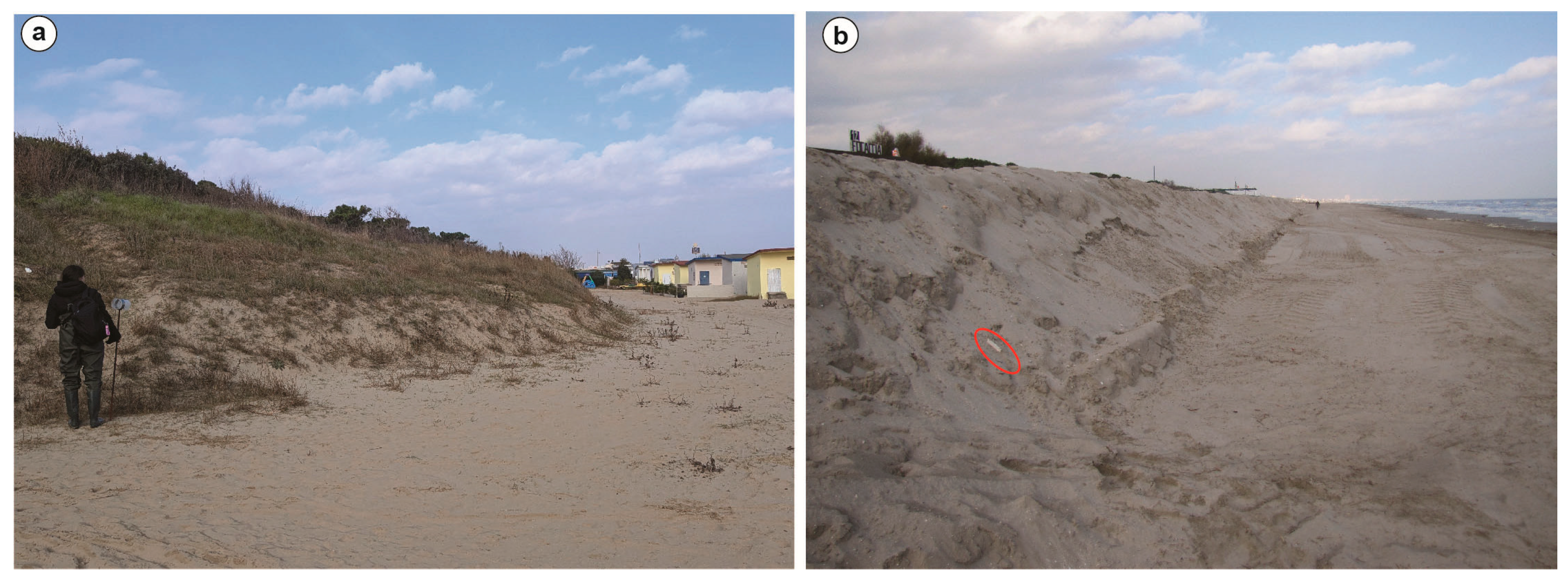
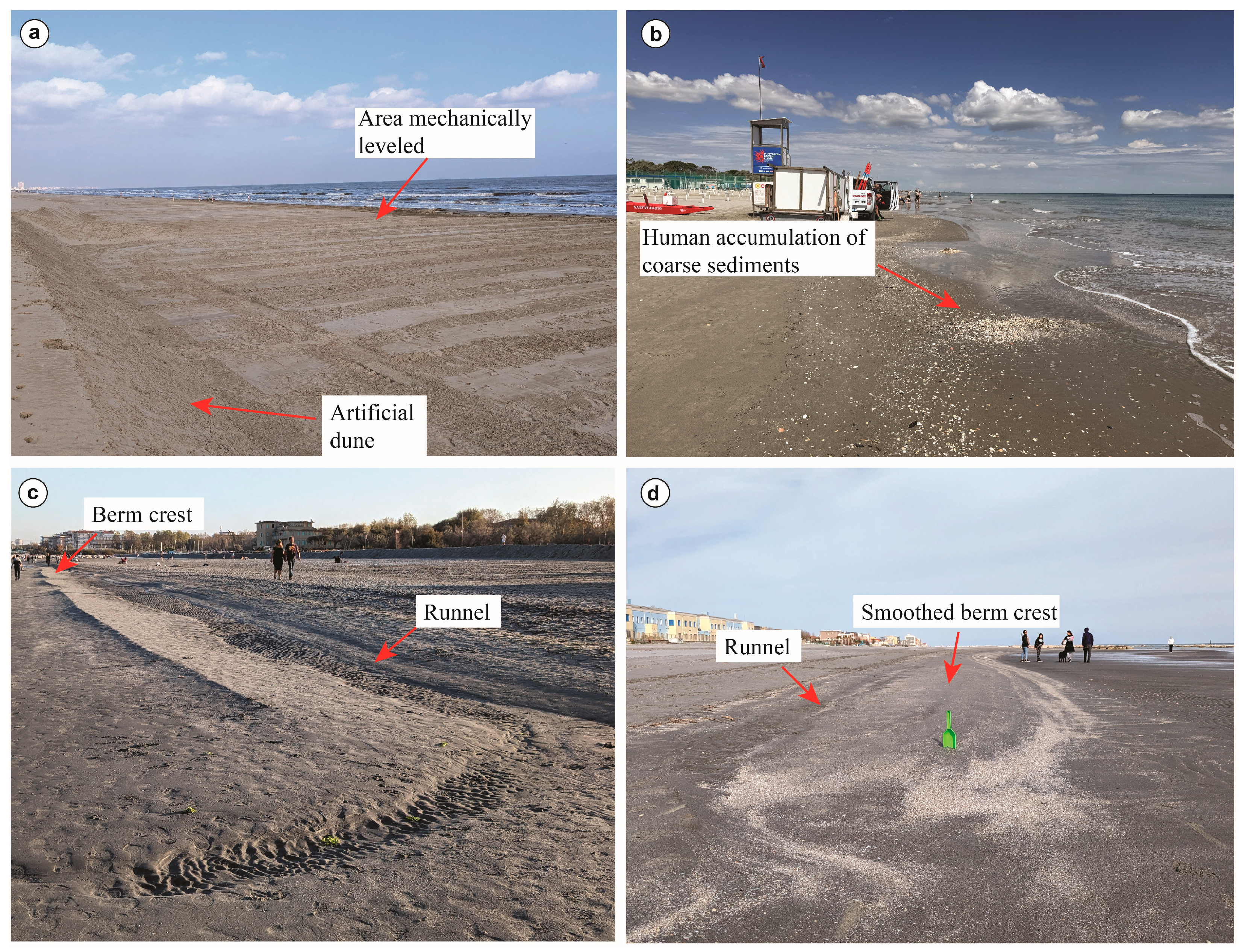
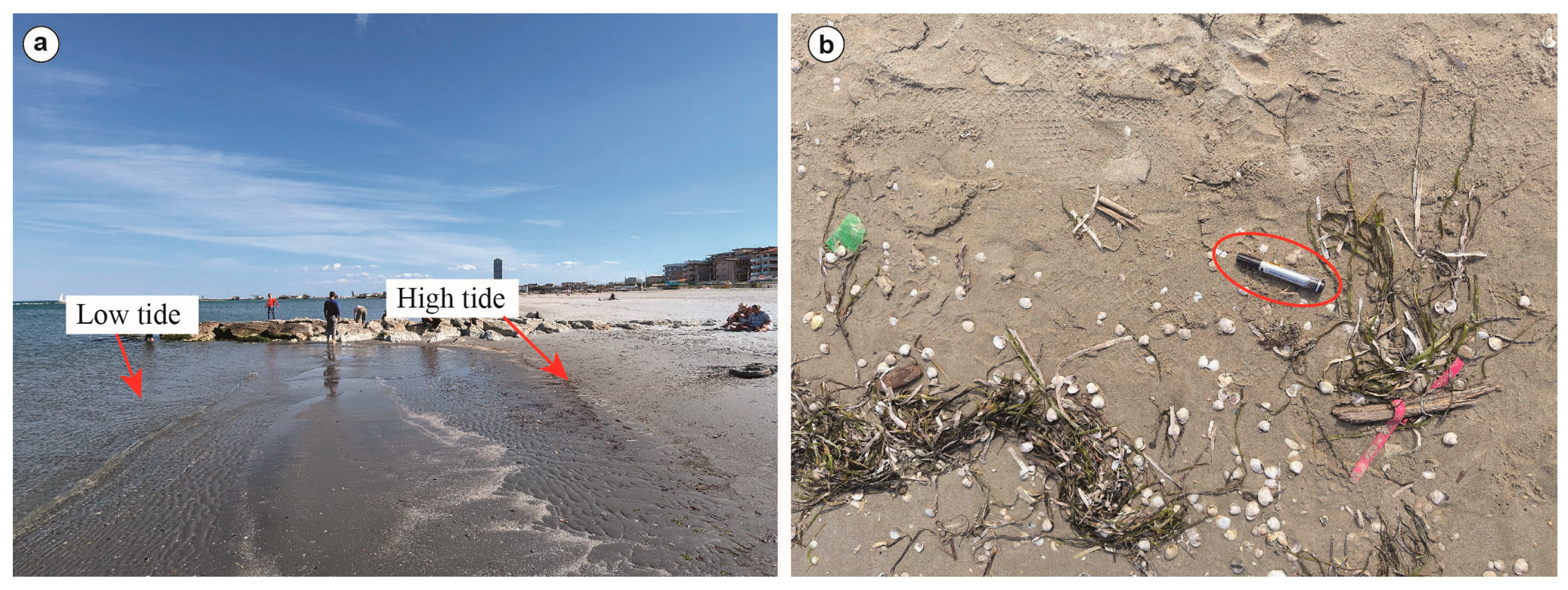

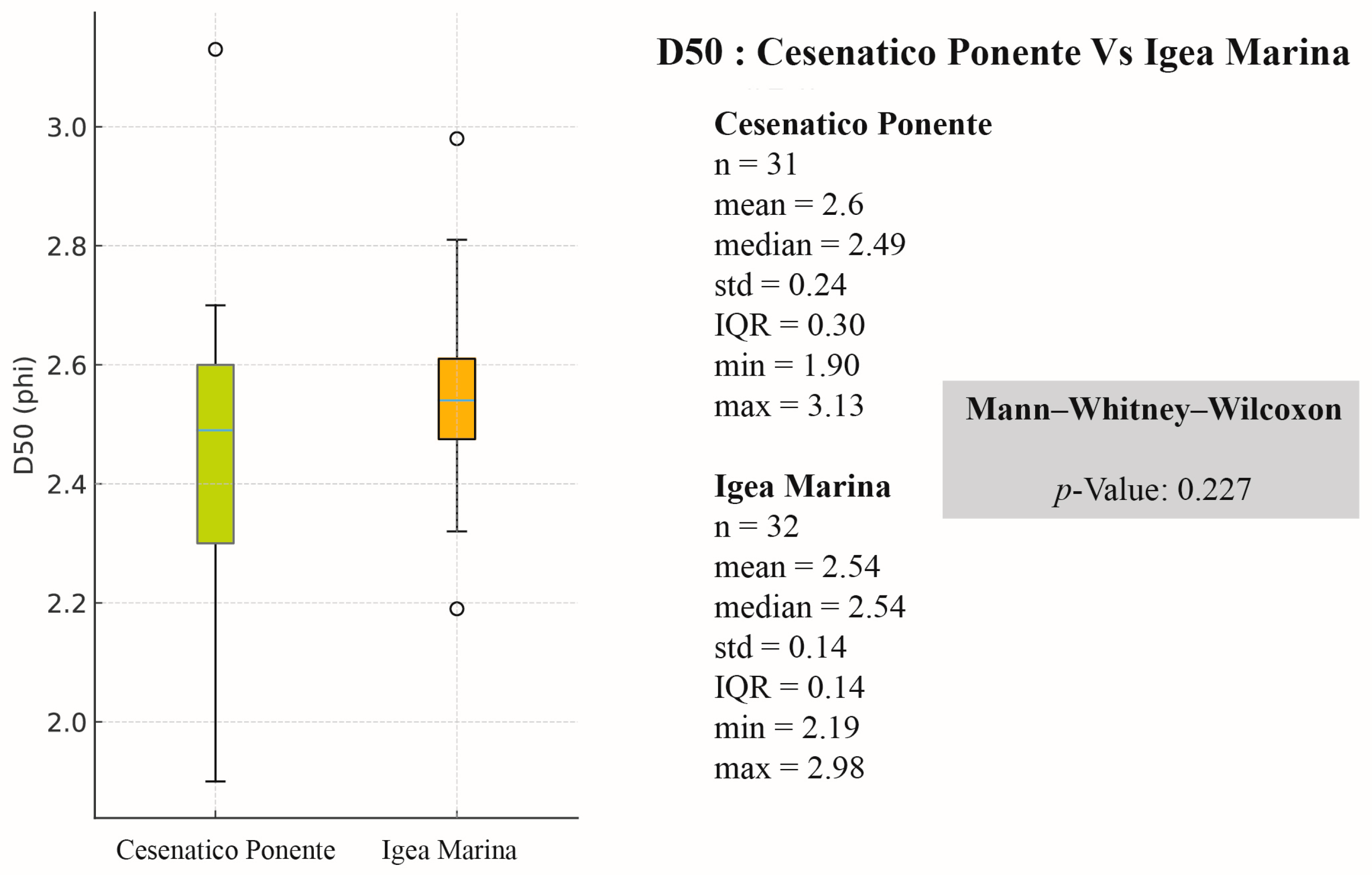
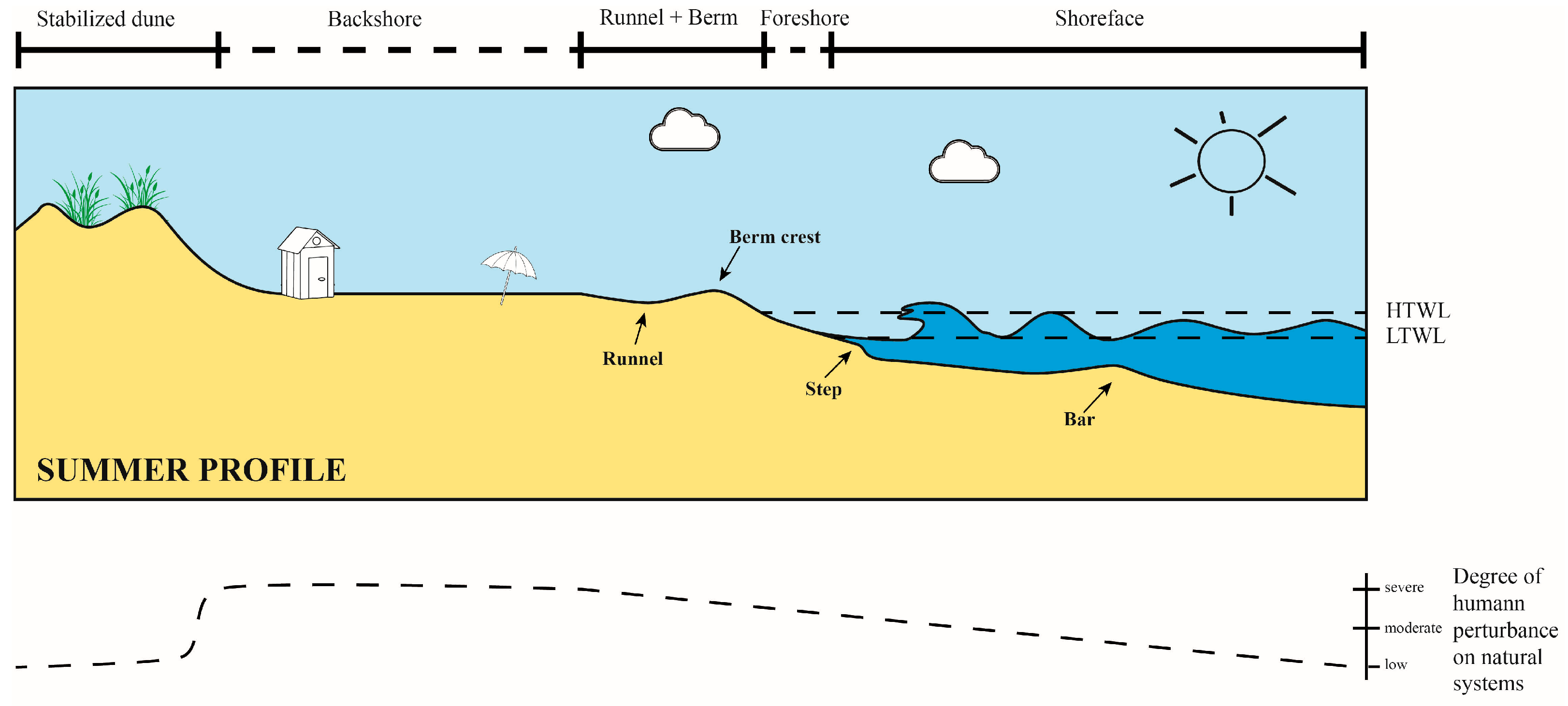
| Environment | Season | N | Median (Φ) | U-Test (p-Value) | MAD (Φ) | Min-Max (Φ) | Range (Φ) |
|---|---|---|---|---|---|---|---|
| Berm | winter | 8 | 2.37 | 0.041 | 0.12 | 2.05/2.53 | 0.48 |
| Berm | summer | 8 | 2.52 | 0.06 | 2.40/2.61 | 0.21 | |
| Foreshore | winter | 8 | 2.56 | 0.875 | 0.05 | 2.09/2.65 | 0.56 |
| Foreshore | summer | 8 | 2.51 | 0.11 | 1.90/2.70 | 0.80 | |
| Step | winter | 8 | 2.42 | 0.148 | 0.07 | 2.37/2.69 | 0.32 |
| Step | summer | 7 | 2.32 | 0.09 | 2.11/2.55 | 0.44 | |
| Shoreface | winter | 8 | 2.60 | 0.372 | 0.07 | 2.49/3.13 | 0.64 |
| Shoreface | summer | 8 | 2.63 | 0.04 | 2.58/2.81 | 0.48 |
| Environment | Protection | N | Median (Φ) | U-Test (p-Value) | MAD (Φ) | Min-Max (Φ) | Range (Φ) |
|---|---|---|---|---|---|---|---|
| Berm | partial | 8 | 2.46 | 0.793 | 0.11 | 2.05/2.57 | 0.52 |
| Berm | total | 8 | 2.48 | 0.03 | 2.19/2.61 | 0.42 | |
| Foreshore | partial | 8 | 2.55 | 0.875 | 0.06 | 1.90/2.70 | 0.80 |
| Foreshore | total | 8 | 2.54 | 0.08 | 2.37/2.63 | 0.26 | |
| Step | partial | 7 | 2.32 | 0.005 | 0.06 | 2.11/2.37 | 0.26 |
| Step | total | 8 | 2.53 | 0.06 | 2.32/2.69 | 0.37 | |
| Shoreface | partial | 8 | 2.63 | 0.713 | 0.04 | 2.49/3.13 | 0.64 |
| Shoreface | total | 8 | 2.61 | 0.04 | 2.50/2.98 | 0.48 |
| Environment | Season | N | Median (Φ) | U-Test (p-Value) | MAD (Φ) | Min-Max (Φ) | Range (Φ) |
|---|---|---|---|---|---|---|---|
| Berm | winter | 8 | 2.18 | 0.007 | 0.19 | 1.93/2.48 | 0.55 |
| Berm | summer | 8 | 2.49 | 0.06 | 2.58/2.37 | 0.21 | |
| Foreshore | winter | 8 | 2.47 | 0.637 | 0.06 | 1.59/2.59 | 1.00 |
| Foreshore | summer | 8 | 2.41 | 0.13 | 1.77/2.61 | 0.84 | |
| Step | winter | 8 | 2.32 | 0.165 | 0.15 | 1.96/2.51 | 0.55 |
| Step | summer | 7 | 2.11 | 0.20 | 1.67/2.37 | 0.70 | |
| Shoreface | winter | 8 | 2.55 | 0.495 | 0.10 | 2.38/3.11 | 0.74 |
| Shoreface | summer | 8 | 2.60 | 0.06 | 2.53/2.76 | 0.23 |
| Environment | Protection | N | Median (Φ) | U-Test (p-Value) | MAD (Φ) | Min-Max (Φ) | Range (Φ) |
|---|---|---|---|---|---|---|---|
| Berm | partial | 8 | 2.41 | 0.875 | 0.15 | 1.93/2.58 | 0.64 |
| Berm | total | 8 | 2.41 | 0.08 | 2.06/2.57 | 0.51 | |
| Foreshore | partial | 8 | 2.46 | 0.793 | 0.09 | 1.59/2.59 | 1.00 |
| Foreshore | total | 8 | 2.46 | 0.09 | 2.23/2.61 | 0.38 | |
| Step | partial | 7 | 2.07 | 0.009 | 0.10 | 1.67/2.31 | 0.64 |
| Step | total | 8 | 2.34 | 0.08 | 2.02/2.51 | 0.49 | |
| Shoreface | partial | 8 | 2.58 | 0.875 | 0.06 | 2.38/3.11 | 0.74 |
| Shoreface | total | 8 | 2.59 | 0.06 | 2.42/2.94 | 0.53 |
| Environment | Season | N | Median | U-Test (p-Value) | MAD | Min-Max | Range |
|---|---|---|---|---|---|---|---|
| Berm | winter | 8 | 0.36 | 0.005 | 0.01 | 0.37/0.96 | 0.59 |
| Berm | summer | 8 | 0.71 | 0.13 | 0.33/0.45 | 0.12 | |
| Foreshore | winter | 8 | 0.52 | 0.637 | 0.08 | 0.41/1.08 | 0.68 |
| Foreshore | summer | 8 | 0.66 | 0.14 | 0.35/1.17 | 0.82 | |
| Step | winter | 8 | 0.72 | 0.385 | 0.19 | 0.46/1.09 | 0.59 |
| Step | summer | 7 | 0.78 | 0.14 | 0.61/1.29 | 0.68 | |
| Shoreface | winter | 8 | 0.44 | 0.495 | 0.05 | 0.32/0.64 | 0.33 |
| Shoreface | summer | 8 | 0.42 | 0.03 | 0.36/0.58 | 0.22 |
| Environment | Protection | N | Median | U-Test (p-Value) | MAD | Min-Max | Range |
|---|---|---|---|---|---|---|---|
| Berm | partial | 8 | 0.42 | 0.495 | 0.09 | 0.33/0.96 | 0.63 |
| Berm | total | 8 | 0.37 | 0.01 | 0.36/0.74 | 0.38 | |
| Foreshore | partial | 8 | 0.59 | 0.270 | 0.13 | 0.35/1.17 | 0.82 |
| Foreshore | total | 8 | 0.48 | 0.08 | 0.38/0.76 | 0.38 | |
| Step | partial | 7 | 0.90 | 0.093 | 0.14 | 0.46/1.29 | 0.83 |
| Step | total | 8 | 0.68 | 0.09 | 0.52/0.96 | 0.43 | |
| Shoreface | partial | 8 | 0.44 | 0.431 | 0.03 | 0.32/0.64 | 0.33 |
| Shoreface | total | 8 | 0.42 | 0.04 | 0.36/0.53 | 0.17 |
| Environment | Season | N | Median | U-Test (p-Value) | MAD | Min-Max | Range |
|---|---|---|---|---|---|---|---|
| Berm | winter | 8 | −1.47 | 1.000 | 0.53 | −2.16/0.04 | 2.20 |
| Berm | summer | 8 | −1.44 | 0.26 | −1.96/−0.80 | 1.15 | |
| Foreshore | winter | 8 | −1.44 | 0.431 | 0.20 | −2.66/−0.78 | 1.88 |
| Foreshore | summer | 8 | −1.91 | 0.45 | −2.33/−0.82 | 1.51 | |
| Step | winter | 8 | −2.05 | 0.093 | 0.29 | −2.43/−1.23 | 1.20 |
| Step | summer | 7 | −1.57 | 0.20 | −1.84/−0.65 | 1.19 | |
| Shoreface | winter | 8 | −1.91 | 0.637 | 0.34 | −2.98/−1.46 | 1.53 |
| Shoreface | summer | 8 | −1.67 | 0.66 | −2.82/−0.51 | 2.31 |
| Environment | Protection | N | Median | U-Test (p-Value) | MAD | Min-Max | Range |
|---|---|---|---|---|---|---|---|
| Berm | partial | 8 | −1.16 | 0.128 | 0.447 | −2.13/0.04 | 2.17 |
| Berm | total | 8 | −1.62 | 0.275 | −2.16/−1.08 | 1.09 | |
| Foreshore | partial | 8 | −1.72 | 0.564 | 0.28 | −2.66/−0.78 | 1.88 |
| Foreshore | total | 8 | −1.91 | 0.45 | −2.39/−1.00 | 1.40 | |
| Step | partial | 7 | −1.30 | 0.013 | 0.28 | −2.07/−0.65 | 1.41 |
| Step | total | 8 | −1.94 | 0.28 | −2.43/−1.57 | 0.86 | |
| Shoreface | partial | 8 | −1.74 | 0.495 | 0.27 | −2.49/−0.51 | 1.99 |
| Shoreface | total | 8 | −2.09 | 0.63 | −2.98/−1.18 | 1.80 |
Disclaimer/Publisher’s Note: The statements, opinions and data contained in all publications are solely those of the individual author(s) and contributor(s) and not of MDPI and/or the editor(s). MDPI and/or the editor(s) disclaim responsibility for any injury to people or property resulting from any ideas, methods, instructions or products referred to in the content. |
© 2025 by the authors. Licensee MDPI, Basel, Switzerland. This article is an open access article distributed under the terms and conditions of the Creative Commons Attribution (CC BY) license (https://creativecommons.org/licenses/by/4.0/).
Share and Cite
Martini, I.; Canapini, L.; Terzi, L.; Burgassi, A. Assessing Grain-Size and Sedimentological Variations in Human-Modified Beaches: Insights from the Northern Adriatic Coast (Italy). J. Mar. Sci. Eng. 2025, 13, 2230. https://doi.org/10.3390/jmse13122230
Martini I, Canapini L, Terzi L, Burgassi A. Assessing Grain-Size and Sedimentological Variations in Human-Modified Beaches: Insights from the Northern Adriatic Coast (Italy). Journal of Marine Science and Engineering. 2025; 13(12):2230. https://doi.org/10.3390/jmse13122230
Chicago/Turabian StyleMartini, Ivan, Leonardo Canapini, Lorenzo Terzi, and Allegra Burgassi. 2025. "Assessing Grain-Size and Sedimentological Variations in Human-Modified Beaches: Insights from the Northern Adriatic Coast (Italy)" Journal of Marine Science and Engineering 13, no. 12: 2230. https://doi.org/10.3390/jmse13122230
APA StyleMartini, I., Canapini, L., Terzi, L., & Burgassi, A. (2025). Assessing Grain-Size and Sedimentological Variations in Human-Modified Beaches: Insights from the Northern Adriatic Coast (Italy). Journal of Marine Science and Engineering, 13(12), 2230. https://doi.org/10.3390/jmse13122230






